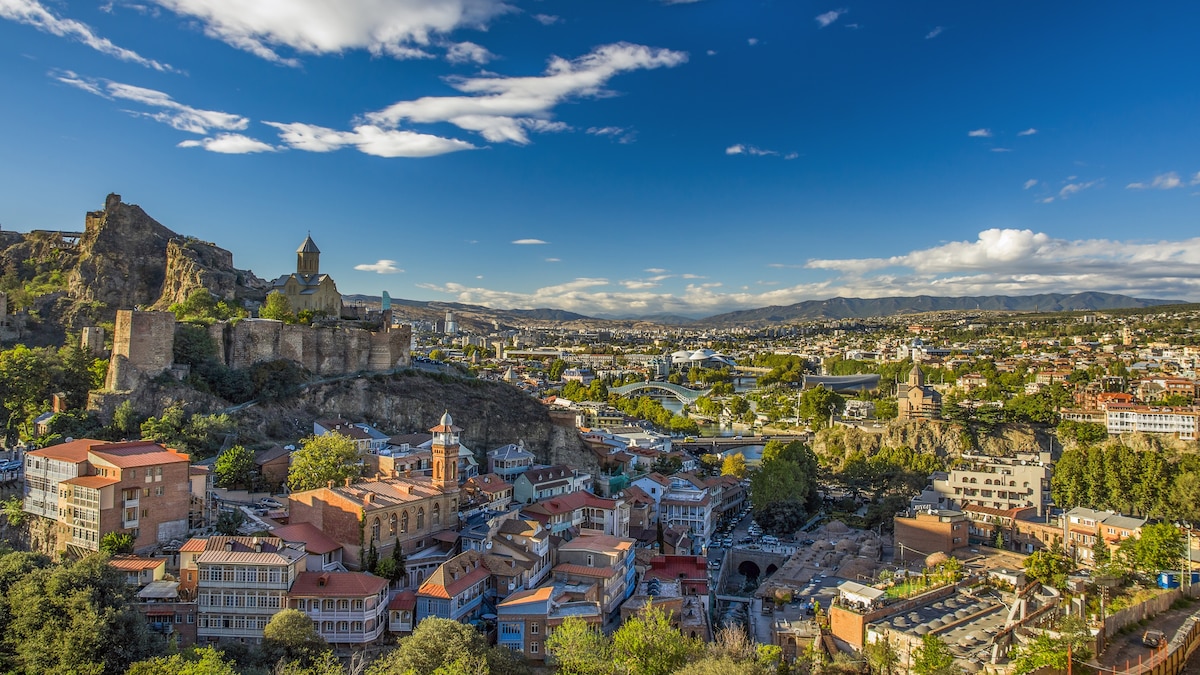Tbilisi is a city of contradictions, where Soviet-era feats of concrete, Silk Road caravanserais and decadent European-style mansions sit cheek by jowl. Moulded by invaders for much of its history, Tbilisi’s skyline can be read like a book, each city block a catalogue of its trials and triumphs.
This is a place where the ancient touches the ultra-modern, from the rippling domes of Abanotubani district’s Persian-style bathhouses to the Jenga-like Bank of Georgia headquarters and the slick Public Service Hall. The Old Town alleyways and pedestrian-friendly avenues make it a rambler’s paradise.
1. Anchiskhati Basilica
Start in the oldest part of Tbilisi, the Kala district, which unrolls at the stony feet of Narikala Fortress. Here, you’ll find one of the few buildings to have survived a 1795 Qajari assault that flattened the city: Anchiskhati Basilica, Tbilisi’s oldest-surviving Orthodox church, off bustling Shateli Street.
Dating back to the sixth century, the petite church wasn’t designed to wow, but instead was built with acoustics in mind. Visit on a Sunday morning to hear liturgical chanting performed by the renowned house choir. Nearby, you’ll find a theatre and clock tower created by Georgian playwright and theatre director Rezo Gabriadze; the imaginative complex was assembled from debris collected in the wake of an earthquake.
2. The Writers’ House of Georgia
After the jumble of streets that is Kala, Sololaki, just a 10-minute stroll away, feels positively Parisian. Tbilisi’s first planned residential district outside the old city walls, it’s characterised by gridded blocks and tidy facades, an expression of Georgia’s westward pivot that occurred at the turn of the century. Sololaki is famed for its art nouveau gems, chief among them the Writer’s House of Georgia, a blend of art noveau and neobaroque styles. A collaboration between German architect Carl Zaar and Tbilisi-based duo Aleksander Ozerov and Korneli Tatishev, it was built in 1905 for the brandy baron and philanthropist David Sarajishvili. A terrace adorned with custom-made Villeroy & Boch tiles and a timber interior fashioned by local craftsman Ilia Mamatsashvili are among the highlights. The building now houses two museums, a cafe and a five-room hotel.
3. Tbilisi Opera and Ballet Theatre
Cross Freedom Square, where a gilded statue of St George looms above the fray, to reach downtown Tbilisi’s main thoroughfare, Shota Rustaveli Avenue — named after Georgia’s national poet. As you drift along the sidewalk, look for the painted plaques that bear aphorisms from his 12th-century epic poem The Knight in the Panther’s Skin.
The avenue’s leading lady, Tbilisi Opera and Ballet Theatre was established in 1851 and has been located inside this gold-and-burgundy building since 1896. Designed by German architect Victor Schröter, it was considered the primary outpost of European culture on the Russian Empire’s western frontier. Somewhat counterintuitively, it draws heavily on Eastern and neo-Moorish forms. Visit the box office and buy a ticket to view the lavish interior, with its plaster muqarnas, Qajar-style mirror work and ornate coloured glass.
4. The former Palace of Rituals
Follow the curve of the Kura River through Avlabari, the historic Armenian Quarter, to reach the Palace of Rituals. The gold standard of postmodernism in Tbilisi, it was created by Victor Djorbenadze (aka the ‘Georgian Le Corbusier’), who managed to weave overt ecclesiastical references into his Soviet-sanctioned blueprints. The cathedral-like bell tower that rises between twin conch-shaped halls has phallic undertones, and when viewed from above, the building’s contours mirror the female reproductive system.
When it opened in 1985, the palace served as a wedding venue, among other things. It was shuttered in the 1990s with the fall of the USSR and later purchased by a private investor. Tours take place occasionally. Alternatively, you can view it from the nearby Aragveli Bridge, where the dam of the Soviet-era Ortachala Hydroelectric Power Plant is also in frame.
5. The Bridge of Peace
To end your walk, head back to the city centre via the Bridge of Peace. Designed by Italian architect Michele De Lucchi, the 2010 pedestrian bridge’s curved, steel-and-glass canopy raised a few eyebrows when it was first built. It’s since been embraced as a symbol of modern Tbilisi. Come sunset, 1,200 LEDs illuminate the bridge and pulse with rhythmic light arrays. Other ambitious construction projects, including the Rike Concert Hall and former Presidential Palace, can be seen from nearby Rike Park, a sprawling green space which, if viewed from above, resembles a map of Georgia.
There are direct flights from London to Tbilisi with several airlines. For more information visit tbilisi.gov.ge
To subscribe to National Geographic Traveller (UK) magazine click here. (Available in select countries only).







